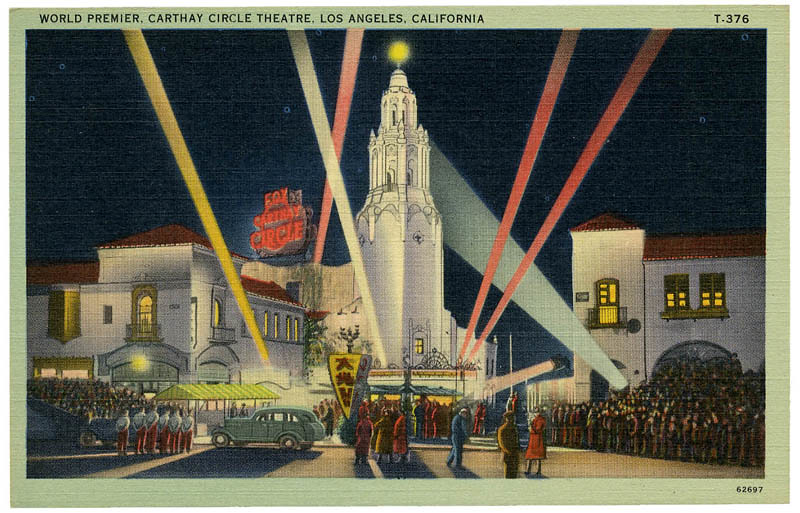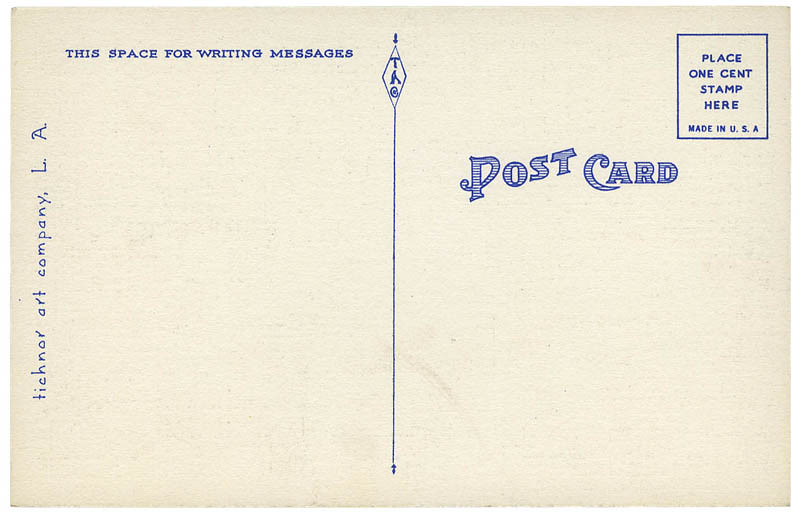Another nighttime postcard, obviously a drawing from a photograph.
The Carthay Circle Theatre was one of the most famous movie palaces of Hollywood's Golden Age. It opened at 6316 San Vicente Boulevard in 1926 and was considered developer J. Harvey McCarthy's most successful monument, a stroke of shrewd thinking that made a famous name of the newly developed Carthay residential district in the Mid-Wilshire district of Los Angeles, California.DesignThe exterior design was in the Spanish Colonial Revival style, with whitewashed concrete trimmed in blue, with a high bell tower and neon sign that could be seen for miles. The architects were Carleton Winslow and Dwight Gibbs. The auditorium itself was shaped in the form of a perfect circle set inside a square that fleshed out the remainder of the building. The iconic octagonal tower was placed in the front corner spandrel space left between the circle and the square. The auditorium's cylinder-shaped wall was raised up above the roof line, to create a parapet visible from the outside that resembled a circus tent. "Simple, massive and dignified, the building stands out for its intrinsic beauty," raved The Architect and Engineer. Pacific Coast Architect wrote that it was a theatre "masked as a cathedral".There was a drop curtain that featured an homage to the pioneer Donner Party, which perished crossing the Sierra Nevada Mountains. Bronze busts of Native American leaders and photographs of Lillie Langtry and other 19th century actors adorned the lounges and lobbies. Paintings of historic scenes forty feet tall graced the walls.

PremieresThe theatre hosted the official premieres of The Life of Emile Zola (1937), Romeo and Juliet (1936), Walt Disney's first animated feature length film Snow White and the Seven Dwarfs (1937) and Gone with the Wind (1939), among many other notable films. For Disney's Fantasia (1940), the most elaborate audio system in use at the time, Fantasound, a pioneering stereophonic process, was installed at this theatre.For the glamorous world premiere of MGM's Marie Antoinette (1938), with Norma Shearer and Tyrone Power, the gardens around the theater were restructured and enhanced to resemble the landscaping of the Palace of Versailles. In the 1930s and '40s, props from the sets of such premiered films as The Great Ziegfeld (1936), The Good Earth (1937), Captains Courageous (1937) and Gone With the Wind (1939) were displayed on the grassy median of McCarthy Vista, from Wilshire Boulevard south to San Vicente Boulevard. The premieres were red-carpet events, with the stars of the motion picture arriving in limousines at the entrance to the covered walkway to the theater south from San Vicente and cheered by hundreds of fans in bleachers there, accompanied by searchlights scanning the sky. Only Grauman's Chinese Theatre in Hollywood also had such elaborate premieres in that era.DeclineBy the 1960s the Carthay was considered obsolete, overshadowed by modern cinemas; its customer base had also been sapped by suburbanization. The theater was demolished in 1969; today, two low-rise office buildings and a city park occupy its former site. (SOURCE: Wikipedia)
I'm not finding any information about the manufacturer, Tichnor Art Company of Los Angeles. So who were these artists that toiled in the back rooms creating these images. Was it freelance work or in-house?













The Tichnor Brothers was a postcard publisher from Boston, Mass. They were very successful and had branch offices in several cities in the United States. I don't know the years they were in business, but after they closed up shop a good portion of their archives ended up at the Boston Public Library. Type in Tichnor Brothers at Google and a Flickr page will come up with a lot of their images-WJY
ReplyDeleteThanks Anonymous for the information.
ReplyDelete